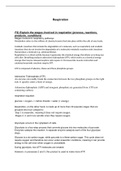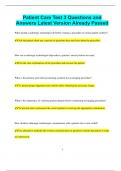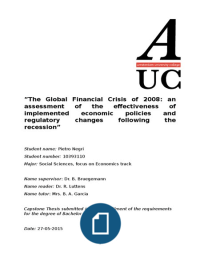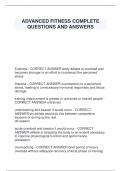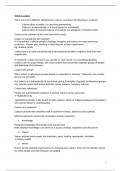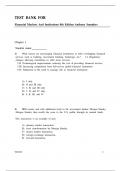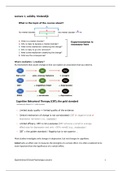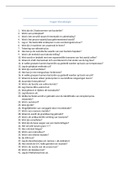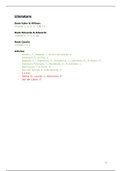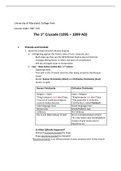Respiration
P2) Explain the stages involved in respiration (process, reactions,
products, conditions)
Stages involved in respiratory pathways
Metabolism refers to the millions of chemical events that take place within the cells of your body.
Catabolic (reactions that include the degradation of a molecule, such as respiration) and anabolic
(reactions that do not involve the degradation of a molecule) metabolic reactions exist (reactions
that produce a molecule e.g., photosynthesis).
Respiration is a critical activity because it generates the chemical energy that allows us to keep our
cells alive. Breathing produces adenosine triphosphate (ATP), which works as a chemical energy
storage that may be released anytime cells require it. Processes like muscle contraction and
catalysed enzymatic reactions require ATP.
ATP is composed of adenine, ribose and three phosphate groups.
Adenosine Triphosphate (ATP)
An enzyme can readily break the connection between the two phosphate groups on the right
side. It quickly emits a burst of energy.
Adenosine diphosphate (ADP) and inorganic phosphate are generated from ATP (not
containing carbon).
respiration equation:
glucose + oxygen -> carbon dioxide + water (+ energy)
Respiration, on the other hand, is made up of more than 30 separate stages that are
grouped into four categories:
Step 1 is anaerobic, meaning it does not require oxygen.
Stages 2, 3, and 4 are aerobic since they require oxygen.
Glycolysis occurs in the cytoplasm of cells.
Glycolysis is a four-step process that converts glucose into two molecules of pyruvate.
Enzymes catalyse the reaction. A separate enzyme catalysis each of the four glycolyse
steps.
Glucose is a six-carbon sugar, while pyruvate is a three-carbon sugar. This cycle does not
require oxygen and therefore can occur under anaerobic conditions, meaning it can provide
energy to the cell even when oxygen is unavailable.
During glycolysis, two ATP molecules are created.
However, in processes 2 and 3, this product is used to make more ATP.
, Phosphorylation is the first stage of glycolysis, which involves adding a phosphate group to a
glucose molecule to activate it and allow it to be divided up.
Stage one of glycolysis.
One ATP molecule is hydrolysed, and one phosphate group is released.
The phosphate group is released and attaches to the carbon 6 of a glucose molecule,
forming glucose-6-phosphate.
This process is catalysed by the enzyme hexokinase.
Fructose 6-phosphate is formed when glucose 6-phosphate is converted.
This reaction is catalysed by the enzyme glucose phosphate isomerase.
Another molecule of ATP is hydrolyzed, and the phosphate group produced during this
process bonds to the 6-phosphate fructose carbon 1 of the fructose sugar.
This produces fructose 1,6-bisphosphate (the phosphate groups are bound to carbon 1 and
6).
This reaction is catalysed by the enzyme phosphofructokinase.
The second stage of glycolysis.
The fractionation of fructose 1,6-bisphosphate for the products to produce ATP is the
second stage of glycolysis.
The molecule of fructose 1,6-bisphosphonates is split into two.
Fructose aldolase diphosphate is the enzyme that catalyses this reaction. Two molecules of
glyceraldehyde 3-phosphate are produced by the enzyme triose phosphate isomerase.
Glyceraldehyde 3-phosphate is formed when fructose 1,6-bisphosphate is broken into two
molecules.
Stage 3 of glycolysis
Glyceraldehyde 3-phosphate loses electrons in the third phase of glycolysis, oxidation. To
make two molecules of 1,3 bisphosphate glycerine, two hydrogen atoms are removed from
each glyceraldehyde 3-phosphate.
Glyceraldehyde phosphate dehydrogenase catalyses this reaction; however, it also requires
the presence of another molecule known as co-enzyme. A co-enzyme is a nonprotein
molecule that is needed for an enzyme to function.
Two nicotinamide adenine dinucleotide (NAD) coenzyme molecules are required. Electron
receptors are what these molecules do.
They receive hydrogen atoms, and two NAD molecules are transformed to NAD or reduced
NADH in this process.
Two NAD co-enzymes are involved in oxidation, which results in two reduced NAD (NADH)
and two 1,3 bisphosphate glycerides from two 3-phosphate glyceraldehyde's.
The fourth stage of glycolysis
P2) Explain the stages involved in respiration (process, reactions,
products, conditions)
Stages involved in respiratory pathways
Metabolism refers to the millions of chemical events that take place within the cells of your body.
Catabolic (reactions that include the degradation of a molecule, such as respiration) and anabolic
(reactions that do not involve the degradation of a molecule) metabolic reactions exist (reactions
that produce a molecule e.g., photosynthesis).
Respiration is a critical activity because it generates the chemical energy that allows us to keep our
cells alive. Breathing produces adenosine triphosphate (ATP), which works as a chemical energy
storage that may be released anytime cells require it. Processes like muscle contraction and
catalysed enzymatic reactions require ATP.
ATP is composed of adenine, ribose and three phosphate groups.
Adenosine Triphosphate (ATP)
An enzyme can readily break the connection between the two phosphate groups on the right
side. It quickly emits a burst of energy.
Adenosine diphosphate (ADP) and inorganic phosphate are generated from ATP (not
containing carbon).
respiration equation:
glucose + oxygen -> carbon dioxide + water (+ energy)
Respiration, on the other hand, is made up of more than 30 separate stages that are
grouped into four categories:
Step 1 is anaerobic, meaning it does not require oxygen.
Stages 2, 3, and 4 are aerobic since they require oxygen.
Glycolysis occurs in the cytoplasm of cells.
Glycolysis is a four-step process that converts glucose into two molecules of pyruvate.
Enzymes catalyse the reaction. A separate enzyme catalysis each of the four glycolyse
steps.
Glucose is a six-carbon sugar, while pyruvate is a three-carbon sugar. This cycle does not
require oxygen and therefore can occur under anaerobic conditions, meaning it can provide
energy to the cell even when oxygen is unavailable.
During glycolysis, two ATP molecules are created.
However, in processes 2 and 3, this product is used to make more ATP.
, Phosphorylation is the first stage of glycolysis, which involves adding a phosphate group to a
glucose molecule to activate it and allow it to be divided up.
Stage one of glycolysis.
One ATP molecule is hydrolysed, and one phosphate group is released.
The phosphate group is released and attaches to the carbon 6 of a glucose molecule,
forming glucose-6-phosphate.
This process is catalysed by the enzyme hexokinase.
Fructose 6-phosphate is formed when glucose 6-phosphate is converted.
This reaction is catalysed by the enzyme glucose phosphate isomerase.
Another molecule of ATP is hydrolyzed, and the phosphate group produced during this
process bonds to the 6-phosphate fructose carbon 1 of the fructose sugar.
This produces fructose 1,6-bisphosphate (the phosphate groups are bound to carbon 1 and
6).
This reaction is catalysed by the enzyme phosphofructokinase.
The second stage of glycolysis.
The fractionation of fructose 1,6-bisphosphate for the products to produce ATP is the
second stage of glycolysis.
The molecule of fructose 1,6-bisphosphonates is split into two.
Fructose aldolase diphosphate is the enzyme that catalyses this reaction. Two molecules of
glyceraldehyde 3-phosphate are produced by the enzyme triose phosphate isomerase.
Glyceraldehyde 3-phosphate is formed when fructose 1,6-bisphosphate is broken into two
molecules.
Stage 3 of glycolysis
Glyceraldehyde 3-phosphate loses electrons in the third phase of glycolysis, oxidation. To
make two molecules of 1,3 bisphosphate glycerine, two hydrogen atoms are removed from
each glyceraldehyde 3-phosphate.
Glyceraldehyde phosphate dehydrogenase catalyses this reaction; however, it also requires
the presence of another molecule known as co-enzyme. A co-enzyme is a nonprotein
molecule that is needed for an enzyme to function.
Two nicotinamide adenine dinucleotide (NAD) coenzyme molecules are required. Electron
receptors are what these molecules do.
They receive hydrogen atoms, and two NAD molecules are transformed to NAD or reduced
NADH in this process.
Two NAD co-enzymes are involved in oxidation, which results in two reduced NAD (NADH)
and two 1,3 bisphosphate glycerides from two 3-phosphate glyceraldehyde's.
The fourth stage of glycolysis

